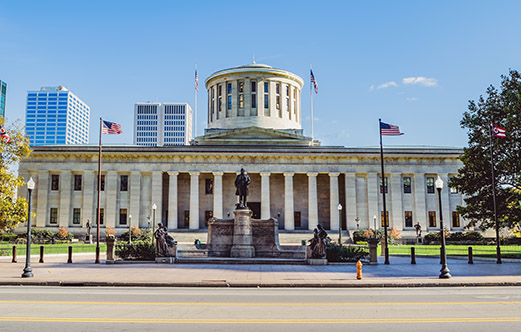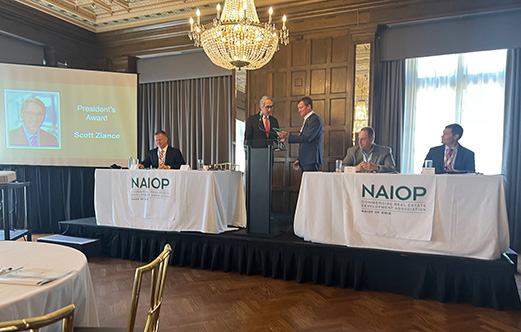
NAIOP Ohio is a statewide association of the four (4) Ohio local chapters. The Ohio chapter boasts over 500 members representing our industry across the state. NAIOP Ohio is supported by a statewide board with trustees representing the 4 local chapters. This 16-member board promotes our initiatives, track issues, and advocates for the real estate industry at the state level.
In summary, our primary pursuit is to assist the progression of economic development activity in Ohio, acting as an advocate of Ohioans and the development community to create jobs, viability, and a quality of life that retains and attracts talent to the State.
Contact
Abe Jacob
aj@mattkallner.com
(419) 789-2516
News
News from NAIOP of Ohio.
NAIOP of Ohio
Officers
President – Michael J. Sikora, III
Vice President – Robert Ballinger
Secretary – Rick Craven
Treasurer and Immediate Past President – Josh Gerth
Central Ohio Chapter
Rick Craven, Sikora Law LLC
Ben Johnson, Colliers International
Chris Knezevic, Vorys, Sater, Seymour and Pease, LLP
Gary Pasheilich, Roetzel
Scott Ziance, Vorys, Sater, Seymour and Pease LLP (Emeritus)
Dayton Area Chapter
Robert Ballinger, Coolidge Wall Co., L.P.A.
Dave Dickerson, Miller Valentine Construction
Mike Grauwelman, Montgomery County Land Reutilization Corp.
Shane Wilken, CityWide Development Corporation
Cincinnati-Northern Kentucky Chapter
James Devanney, Paul Hemmer Company
Josh Gerth, JLL
Peter Horton, Terrex Development
Jerry O’Connell, Bricker Graydon
Northern Ohio Chapter
Craig Miller, Duffy+Duffy Cost Segregation Services
Steve Nowak, Siegel Jennings Co., L.P.A.
Michael Panzica, M. Panzica Development
Michael J. Sikora, III, Sikora Law LLC
Issues
NAIOP of Ohio 2022 Legislative Action Agenda
NAIOP Ohio’s State Operating Budget Priorities for the 135th General Assembly
$500 Million Total for the Brownfield Remediation Program
The Brownfield Remediation Program has supported the redevelopment of contaminated properties. This year, the program has awarded funds for remediation projects in 58 out of Ohio’s 88 counties. The program is currently oversubscribed, and the market has proven that there is a need and justification for additional funding to support the cleanup of contaminated sites throughout Ohio to ready them for productive use.
$250 Million Total for the Building Demolition and Site Revitalization Program
As we turn blighted properties into new opportunities, Ohio is transforming communities and attracting new investments, businesses, and jobs. The first year of this program has already been a success with funding awarded to projects in 87 of Ohio’s 88 counties, but this program is also oversubscribed. Expanding the Building Demolition and Site Revitalization Program would help ready more blighted properties for economic development and growth in Ohio.
$200 Million Total Per Fiscal Year for the Transformational Mixed-Use Development (TMUD) Program
The TMUD Program creates more opportunities for retail, office, residential, and/or recreational space of scale to exist in a single development project. These projects can truly transform a community. Round 1 of the Program, which was oversubscribed, resulted in the Department of Development recommending state support for 13 mixed-use projects, which are expected to spark more than $1 billion in investments throughout Ohio. Round 2 of the Program was once again significantly oversubscribed as 12 more mixed-use projects were awarded tax credits. Increasing the amount of tax credits that can be awarded in a fiscal year to $200 million from $100 million will facilitate more development opportunities that have the potential for tremendous impact.
Increase to $50 Million the Opportunity Zone Allocation for Fiscal Year 2025
The Ohio Opportunity Zone Tax Credit Program has stimulated and accelerated development in many of Ohio’s historically underserved areas, paring well with the Federal Opportunity Zone Program created by the 2017 Tax Cuts and Jobs Act. Over $32 million was applied for in the most recent round of that Program, based upon a year’s-worth of investments. Only $25 million is provided for that Program in the second year of the upcoming biennial cycle. If that Program runs out of funding, just several years into the Program, when it is finally gaining real momentum, it will crush interest in investment in those areas, because developers and their investors would have already committed their funds to those projects, but would not receive the corresponding financial incentives that curb some of the risks they face by investing in those areas.
Updating the Requirements for Electronic Means of Recording Instruments
Originally House Bill 237 of the 134th General Assembly, this language would modernize Ohio’s system of recording instruments, improve, and streamline the ability to complete real estate transactions.
- The ability to file and access recorded instruments remotely would provide a practical benefit to commercial real estate professionals throughout Ohio and the parties to real estate transactions, including sellers, buyers, lenders, and borrowers. The pandemic highlighted how important it is to be able to access and record instruments to complete transactions and doing so electronically should be the safest and most efficient approach.
Proportional JVSD Compensation for Property Tax Exemptions
Clarify that a joint vocational school district (JVSD) shall receive compensation in proportion to how the JVSD is allocated property tax revenue funding relative to the traditional school district.
- Traditional school district’s millage can be roughly 15 to 20 times greater than the JVSD’s millage, and the school district is giving up a far greater portion of revenue due to an exemption; therefore, it is not logical that the JVSD would receive the same compensation. The lack of clarity regarding how to interpret “at the same rate and under the same terms received” is leading to additional back and forth between the parties, thus slowing development projects down.
TIF Exemption Commencement
Clarify that tax increment financing (TIF) exemptions can begin on a parcel-by-parcel basis by the earlier of (i) the tax year in which the value of an improvement exceeds a specified amount or (ii) a certain year.
- Under current law, the triggers for when a TIF exemption may commence may not facilitate the desired goal of a TIF or maximize the value of the TIF. The proposed change will provide added flexibility to meet the needs of development projects and maximize the value of the TIF for jurisdictions and developers.
TIF Process Simplification
For non-school TIFs (i.e., those in which school districts receive TIF revenue equal to what they otherwise would receive in property tax revenue), simplify all of the TIF statutes to eliminate (i) the requirement that the school district board of education approve the TIF and (ii) the school district notice requirements.
- Under current law, even though school districts are made whole under non-school TIFs, county and township TIFs require the school district to approve non-school TIFs (even though that approval is not required for municipal TIFs). Additionally, the ORC requires notices to be provided to the school districts for non-school TIFs even though the school district is not impacted. These requirements create added steps in the administrative process and can increase costs through legal or service provider fees for the jurisdictions, developers/companies and traditional school districts.
2022 Legislative Success
- NAIOP of Ohio recently led the way in helping to draft and secure the enactment of statutory amendments to clarify the scope of community reinvestment area real property tax exemptions for renovated buildings and to clarify the scope of real property tax exemptions for properties for which covenants not to sue are issued. Before these clarifications, some developers undertaking challenging redevelopment projects were not securing the property tax exemptions that they expected based on the intent of those laws.
- NAIOP of Ohio board members regularly meet proactively with federal and state environmental regulators to help the regulators understand commercial real estate development and how regulations impact the development community.
- The NAIOP of Ohio board regularly hosts state political leaders to help them understand matters of importance to the commercial real estate community and to build constructive relationships with them. Within the past couple years, the board has met with both major parties’ gubernatorial tickets, the Senate President, and the Speaker of the House.
- NAIOP of Ohio was a lead advocate behind the enactment of state legislation that authorized local governments to approve property tax exemptions for the increase in value of property planned for commercial or industrial development while the property is in the pre-development stage.
- NAIOP of Ohio was a lead advocate behind the enactment of state legislation that made important revisions to Ohio’s recording curative statute to make it more consistent with that of other states.
Economic Impacts of Commercial Real Estate
Commercial real estate development in Ohio is a powerful economic engine, creating jobs and generating significant fiscal contributions to local, state and national economies in 2024:
A Look at Ohio
Contributions to the state economy (GDP).... $31.7 billion
Wages and salaries generated.... $9.5 billion
Jobs created and supported..... 163,517







